Well head: design, types of structures, installation and installation rules
Installing the head is not the most difficult part of the work when building your own well.Neither the device itself nor the procedure for its installation are particularly complicated. By following certain rules, you can install a well head with your own hands without any problems.
But first it won’t hurt to get acquainted with some of the nuances of this process. We will tell you which head is best to use, and also describe the technology for its installation. Lovers of homemade products will find the instructions for self-assembling a simple device for a well useful.
The content of the article:
Why is a header needed?
In short, the cap is the cap for the well. With its help, the upper part of the casing is protected from the influence of negative external factors. You can do without this device by replacing it with an inverted container of a suitable size, with which the well is simply covered.
Some people wrap the pipe with a large piece of plastic film and think that this is quite enough. However, none of these options is absolutely reliable when well construction.
A film or an inverted tank can only be considered as a temporary protection option. These remedies are almost always powerless against spring floods, insect penetration and other similar factors.

The functions of the well head in practice are much broader than it might seem at first glance.
The device helps to successfully solve a number of important practical problems:
- hermetically protect the upper part of the well from the penetration of flood waters and other unwanted liquids;
- prevent dirt, dust, debris, etc. from entering the well;
- protect the mine from small objects that may fall there;
- additionally protect the well from freezing in winter;
- securely fasten the submersible pump and water supply lines;
- prevent theft of pump and well equipment.
Reliable head improves well operation and maintenance. It is even believed that a sealed cap has a positive effect on the flow rate of filter wells, since this creates additional pressure.
A good head can also be used as an adapter if it is necessary to use water supply pipes of different diameters.
What you should know about headers
It is not difficult to purchase a head in a hardware store; the choice of these devices is quite wide. First of all, you should select the head in exact accordance with the size of your casing pipe. The second important point is the material from which the device is made.
The following types of heads are available for sale:
- plastic — can withstand loads up to 200 kg;
- steel — loads of no more than 500 kg are allowed
- cast iron - are able to withstand over 500 kg, but they themselves weigh a lot.
To save money, many prefer a steel head over a cast iron model. Of course, a steel product costs noticeably less. But it should be remembered that the service life of such a model is noticeably shorter.
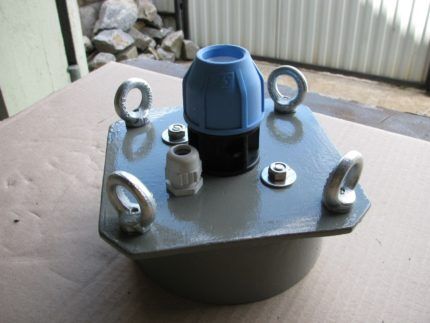
Typically, for a relatively shallow well, up to 50 m deep, you can take a plastic or steel model, since the load in such cases rarely exceeds 100 kg.
But the weight of more powerful equipment for an artesian well can exceed 250 kg. A stronger headband should be used here.
Precise information about the characteristics of the equipment is contained in the technical data sheet of the product, which allows you to find out all the nuances before purchasing.
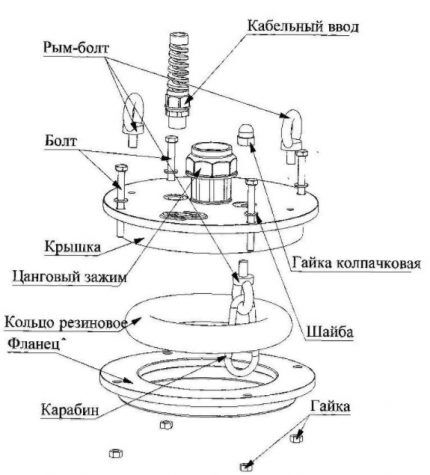
One of the advantages of the well head device is that it is quite simple.
Such a unit consists of three main elements:
- covers;
- flange;
- sealing ring.
Additionally, depending on the model, the device can be equipped with:
- eye bolts;
- cable entry intended for electric drive;
- a set of carbines;
- fitting for water supply pipe;
- mounting bolts.
An eye bolt is a regular bolt, the upper part of which is made in the form of a ring. These elements are used for hanging equipment, securing cables, etc. On the head, eye bolts are placed on top to make it easier to lift the cover, and also on the bottom to hang the pump.
If the model kit does not include eye bolts for some reason, you can purchase them separately if desired and weld them to the metal head.
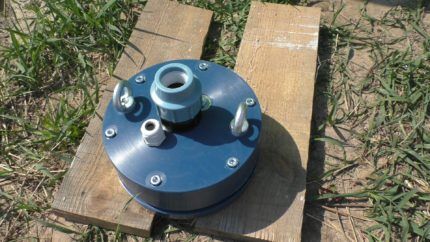
The cable gland is a useful element that allows you to protect the electrical cable from accidental damage. Usually it is equipped with a special spring, which ensures reliable fastening and tightness of the structure. The bolts connecting the cover and flange may be of a special “secret” design.
This allows you to further protect the well from outside interference. If the head is equipped with regular bolts, it makes sense to replace them with fasteners with a secret.
There are elements specifically designed to work in conditions of high humidity, protected from corrosion by a special plastic coating. If possible, you should give preference to such components.
Well heads are usually equipped with special markings, which allow you to immediately get an idea of the characteristics of the product. At the beginning of the inscription there are usually letters OS, they are simply deciphered: “well head”.
The first number indicates the dimensions of the casing for which the product is intended.If only one number is indicated, then the device is only suitable for pipes of that specific diameter.
If a range is indicated, for example, 140-160, then such a head can be installed with casing pipes of various diameters within these limits. The second number indicates the parameters of the water supply pipe that can be connected to this head.
Plastic heads are additionally marked with the letter "P", but there is no such marking on metal products.
Thus, if a product is marked OS-152/32P, this is a head made for a casing pipe with a diameter of 152 mm, which is equipped with an adapter for a water pipe with a diameter of 32 mm. The product is made of plastic.
If the marking looks like OS-152/32, this is a product with exactly the same characteristics, but made of metal.
The price for a finished head can range from $50 to $120. These are approximate prices; if you wish, you can find a cheaper option. However, it should be remembered that purchasing a model at too attractive a price may be fraught with unpleasant surprises associated with poor workmanship.
Currently, well heads from the company are very popular "Dzhileks".
Device installation rules
Since the design of the head as a whole is very simple, its installation should not cause any special problems. And yet there are certain rules that must be followed during installation work.
When installing a well head, the following procedure is usually followed:
- Prepare the edge of the casing pipe.
- The flange is placed on the pipe so that its side is directed downwards.
- Install the O-ring.
- Secure the pump cable.
- An electrical cable is passed into the corresponding entrance.
- A hose or part of a water supply pipe is connected to the fitting, the other end of which is attached to the pump.
- The pump is lowered into the well.
- The lid closes under the weight of the submersible pump.
- The flange and cover are connected with bolts, which are tightened evenly.
Preparing the edge of the casing pipe begins with cutting its edge strictly horizontally. This will allow the head to be placed in a plane that is perpendicular to the casing.
Once the pipe is properly cut to the desired height, its edge should be thoroughly polished. To perform these operations, a regular grinder with a set of appropriate circle attachments is quite suitable.
Before installing the head, it is recommended to additionally protect the metal casing pipe with special metal paint. The O-ring is sometimes difficult to fit onto the casing, and pushing it down is also not always easy.
To solve the problem, it is recommended to use a suitable lubricant, such as Autol or special oil.
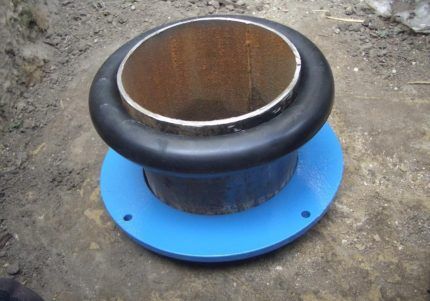
In a hurry to get water from a finished well, some property owners immediately lower the pump into it, postponing the installation of the well head “for later.” This is the wrong procedure. First put on the flange and O-ring, and then you can lower the pump into the well. Otherwise, to install the head, you will have to take it out and lower it again.
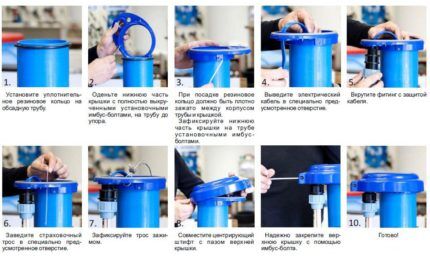
This is not the best option, since the risk of damage to the column and equipment increases, and the procedure itself is quite labor-intensive. To secure the cable to the pump and head, special carabiners are used.
The length of the cable must correspond to the immersion depth of the equipment.The pump should not be lowered into the well until all other elements have been placed in the appropriate slots in the head cover.
There is a special clamp on the hole for the electrical cable. It must be slightly loosened so that the cable can slide freely. If a wire is pinched, or positioned so that it bears part of the weight of the equipment, it may break.
Before attaching a water supply pipe or hose to the head, its lower end is connected to submersible pump.
When lowering the pump into the well, the cable should be gradually released. When the equipment is at the selected depth, the cover is closed and the weight of the pump presses it against the flange. In this case, the seal falls into a special groove and is pressed tightly against the casing pipe, which ensures reliable sealing of the structure.
If the head is installed correctly, the O-ring will be evenly pressed by the flange against the cover, and the connection holes will be opposite. If this does not happen, then you need to look for the reason; perhaps you just need to slightly change the position of the cover.
The connecting bolts should be tightened evenly so that the cover does not skew to one side. Don't try to do your best.
An excessively tight connection between the cover and the flange can cause damage to the rubber ring, which leads to a violation of the tightness of the structure. But too weak a connection is also unacceptable. If the bolts are not tightened tightly enough, the head can simply be removed from the pipe, in which case their installation becomes meaningless.
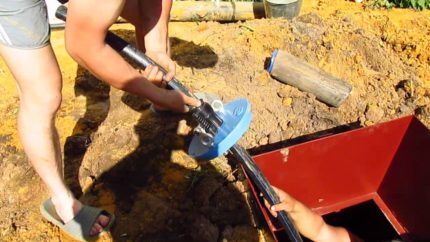
After the cover is installed and secured, there is almost always some sagging in the electrical cable. The wire should be selected in such a way that it does not sag, but is not in a tense state.
Now you can connect the water pipe to the fitting. The pump is then usually turned on to assess the correct installation of the head and its condition under operating load.
Homemade well head
Since the structure of the head is not so complicated, you can make it yourself. For this, stainless steel sheets 10 cm thick are used.
A head made of thinner metal will not be strong enough. But too large dimensions of the material are not needed, since this creates an unreasonably high load on the structure.
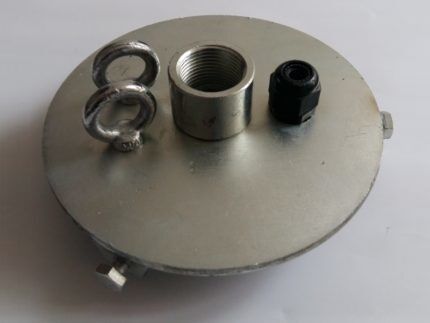
First, the flange is cut out, i.e. round element with a hole inside. The dimensions of this hole must be such that the casing pipe can pass through it freely. The lid is another metal circle, but the holes in it are completely different. A hole is usually made in the center for a water pipe fitting.
Then a hole of smaller diameter is cut out; it is intended for the electrical cable. The hole for the fitting needs to be made quite large; it can be cut using a welding machine. The hole for the cable can be drilled using a drill with a suitable sized drill bit.
Upon completion of cutting and welding work, the holes and other elements of the head should be processed with a file to eliminate irregularities, burrs, etc.
You will also need to weld three eye bolts to the cover. One of them is welded to the underside of the cover; it will become a loop for attaching the cable on which the pump is suspended.
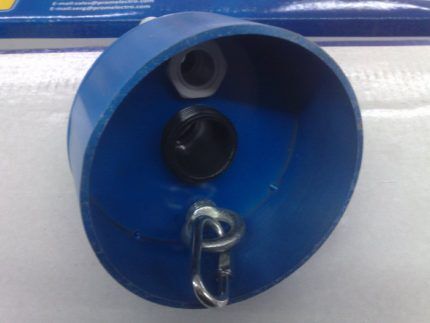
Two eye bolts are welded to the top side of the cover. They will become a kind of handle with which the head can be freely opened. If desired, eye bolts can be replaced with an eye nut; sometimes it is even more convenient to use than a bolt.
Some craftsmen successfully replaced this element with a piece of metal rod of suitable diameter rolled into a circle.
It is also necessary to drill holes in the cover and flange for the mounting bolts. It is recommended to drill both elements at the same time, connecting them using a vice or clamp. This will ensure a more accurate alignment of the holes when installing the finished head.
Also, experienced craftsmen advise first making all the necessary holes in the flange and head, and then welding the adapter, eye bolts, etc. Of course, mounting bolts should be purchased in advance.
Their diameter must match the holes and their length must be sufficient to connect the cover, flange and gasket installed between them.
While cutting and welding sheet metal usually does not cause any difficulties, even experienced craftsmen may have problems finding a suitable gasket.The most reliable way to purchase the necessary element is to buy it from the manufacturer or in a specialized store.
Unfortunately, commercially produced gaskets with standard sizes are not always suitable for a homemade head. The gasket can be cut from a piece of thick rubber, if you have one on hand. It is believed that a layer of rubber 5 mm thick will be sufficient. The inner diameter must be made so that it fits tightly onto the casing.
This will ensure that the head is sufficiently sealed once it is assembled. Some craftsmen recommend using a ring rolled from an old inner tube as a gasket. A non-standard idea for making a gasket is to cast it from silicone. However, in this case you need to make a mold of the appropriate size and configuration.
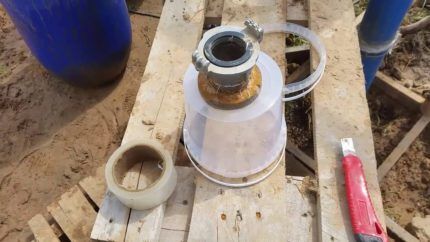
In any case, the gasket must be strong enough to ensure reliable sealing of the head and last a long time. This element is under constant compressive pressure. Poor quality rubber may soon collapse, weakening the connection of the structure.
When installing a homemade well head, it is recommended to protect the electrical cable with a special heat-shrink sleeve. To install it you will need a hair dryer.
Some craftsmen, instead of the lower flange, use three metal corners, which are simply carefully welded to the metal casing pipe.The design of the cover in this case remains the same, and mounting holes are drilled both in the corners and in the cover.
Conclusions and useful video on the topic
The process of installing the head can be seen in the video below, although it does not reflect the procedure for connecting communications, hanging the pump, etc.
Here you can see an overview of various models of well heads:
An interesting do-it-yourself version of the header is presented in the following video:
A good well head is an important part of the water supply system for your home and site. If the model is selected and installed correctly, the cap will reliably protect the well and extend its service life.
Do you have practical skills in installing a well cap? Share your accumulated knowledge or ask questions on the topic in the comments below. If you made the head yourself, you can attach a photo of your craft.




At my summer cottage, I made and installed the well head myself. Indeed, there is nothing complicated, but the water is always clean. My neighbor at the dacha decided to make it simpler and use plastic film instead of the head. He constantly has problems not only in the fall and spring, but also in the summer when it rains. But as soon as he saw my design, he asked me to make the same one for him. A well head is a really necessary thing.
Good afternoon. A well was drilled at the dacha plot just for irrigation, please tell me.
You can connect the piping station directly without a station, we don’t know how to use a pump
having served longer.